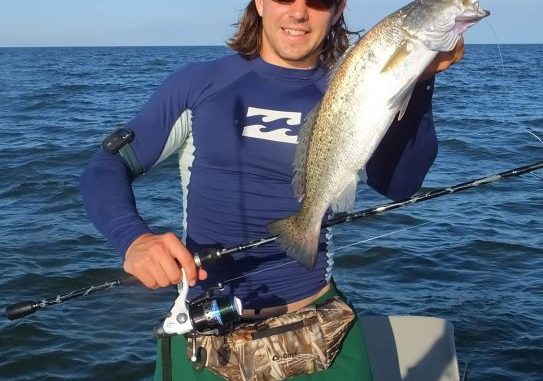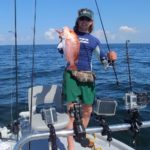
Device provided added sense of security when kayak flipped during Paddlepalooza
Life vests — whether padded or inflatable — are something I’ve never been a big fan of because I dislike anything that has shoulder straps and buckles which dig into my skin and also impede my ability to move around easily aboard a vessel.
However, I am now an avid wearer of a different type of personal floatation device that I stumbled across which causes none of these aggravations — I’m talking about waist or fanny pack PFDs.
I had never seen one before until I came across a couple at a charity auction event sponsored by my wife’s cancer center where there were two camouflaged ones (brand name Onyx) that caught my eye. I realized instantly this was a game changer for my boating safety, put in the winning bid and ended up snatching the $100 retail PFDs for $75 apiece.
Plain black or blue ones can be found as cheap as $70 on the Internet.
As a kid, I always followed the rules and was forced by good parents to wear a bulky padded lifejacket for all of my boat rides, and have always done so as an adult especially when alone, crossing big bodies of water or when temps were cold.
Even though I’m a college-level sprint swimmer, I fish alone about 90 percent of the time and hate the eerie feeling of not having a life vest on as much as I hate wearing them, especially when I’m miles offshore.
However, that false sense of safety I get while driving through familiar waters at slow speeds has led me to leave them stashed under the boat seat most of the time. Even my brother, who switched to an inflatable vest-style PFD, quit using those because the tab got accidentally pulled while fishing.
Since I always rode in low-horsepower vessels, I never realized the dangers of boating until my 13-foot Boston Whaler flipped in a freak accident in Blind River when my engine hit a submerged log while I was only going 25 mph.
Usually that wouldn’t have been a concern if I had more weight in the boat, but I was setting trail cameras and had practically no gear with me, which caused the boat to spin in the air and toss me in the middle of the bayou.
I watched that prop land way too close to my head, and the several-mile trek through the swamp in socks gave me time to rethink my way before some hunters found me and drove me back.
However, trying to wear PFDs over the past few years has still aggravated me. Just like a baseball pitcher who gets hit in the head from a line drive and still elects not to use the funny-looking padded hat, I kept wearing the kill switch and hoping for the best on quick boat rides — until this year when I came across these cool fanny pack PFDs.
These waist pack versions act similarly to the chest harness style, where a CO2 cartridge is attached to a pull cord, and they can also be manually inflated as well. Plus, the pull tab tucks away nicely, so it won’t get accidentally pulled.
They work very well for surf fishing, too. I never wore a life jacket while surf fishing, and many people don’t, but I’ve always been uneasy about undertow sucking me out to sea. With this PFD, I can venture out as far as I want from shore without worrying about if I get blasted out to the depths.
I really like these fanny packs while kayak fishing, especially after nearly sinking my kayak in this year’s Paddlepalooza rodeo. I made a far paddle out to my favorite spot in darkness where the day before I had caught a 10-plus pound Cajun slam out of my 13-foot Boston Whaler. I was hoping to win a brand new kayak in the tournament, but things never seem to go the same on tourney day.
The big trout weren’t biting at this first location where I was surf fishing next to my anchored kayak. A horrible line of lightning storms from the west started moving through, and without a clue of how long it might last, I decided to paddle back to safety instead of hunkering down on a marsh island.
I planned to paddle back there, and then hit my nearby flounder hole later in the day. But little did I know that ever since I had launched the boat that morning, my kayak had been slowly filling with water from some unknown holes I had drilled into my boat that weren’t plugged when I had added some floats days before.
Most kayaks are nearly impossible to flip, but mine seems impossible not to flip, so days before I had added side floats to keep the tiny 8-foot kayak upright. Last year while shark fishing from this same kayak in the Gulf, I had quite a scare, but the floats were my solution.
Unfortunately, for Paddlepalooza, my new anti-flip strategy had just the opposite effect.
After making it a couple hundred yards crossing a bay back to shore, I finally realized the kayak was sitting much too low and taking on water somehow, but the thunder was rumbling way too close so I decided to just keep paddling for safety. At the halfway point, no matter how hard I paddled, I seemed to be going nowhere.
I revved back and stroked that paddle with all my might — big mistake.
My side floats kept the vessel from flipping sideways, but with all the water rushing to the rear, the kayak’s front end flipped up vertically, throwing me into the water.
Fortunately, I had most of my gear tied down and lost only my bait and the fish that I caught. I swam the now water-filled kick board the remaining quarter mile to the nearest dock, praying I wouldn’t get struck by lightning. I took the shortest route and dragged my gear through the marsh then alongside someone’s camp, and started walking back to my truck over a mile away.
Luckily, the owner had seen the situation unfold and came to give me a lift. Though I never had to inflate my fanny pack PFD, I felt much safer that it was on — even though the lightning still scared the life out of me.
The next day, I installed four more bumper floats to the kayak in the front and back, then double-checked all drilled holes — now it no longer leaks and cannot flip in any direction.
The fanny pack was so comfortable and lightweight that after the trip, I ended up driving all the way home from Grand Isle and washing all my gear before I even realized I was still wearing the PFD five hours after fishing.
Be aware that none of the fanny packs I researched have the instant blow-up feature that some of the more expensive chest harness versions do, so if you get knocked unconscious from a boat crash the waist-pack PFD will do little good.
Look around the next time you’re on the water: The vast majority of boaters will be without a PFD on, but maybe learning about these hassle-free devices may just be the ticket that gets more people wearing PFDs.
Personally, I have been converted and feel much safer when I’m on the water. Now that I’m married, a soon-to-be uncle to my brother’s new baby quadruplets and also working on having a kid myself, I have a lot to live for, so from now on I’ll be wearing my fanny pack PFD in all conditions.
I recommend everyone else to do the same because even though fanny packs aren’t the coolest fashion statement, they surely beat wearing a big orange vest.





